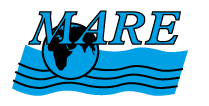A program of the Lawrence Hall of Science that seeks to increase ocean literacy through informal and formal education initiatives
Cadena Alimenticia de la Marisma (The Salt Marsh Nutritional Chain)
Illustrates the biological energy chain of the salt marsh, from the sun to plants, herbivores and carnivores. In Spanish.
The Lawrence Hall of Science Programs for Schools & Community Groups offer several programs for school sites and at the Hall. Assemblies: Dazzling science-on-stage presentations that involve your enthusiastic audience. Perfect for large groups. Workshops: Every student becomes a scientist, immersed in innovative, hands-on science and math activities. Choose from dozens of workshops for all grades in earth science, life science, math, computers, and physical science. Festivals: Involve the whole school community in science and math learning. Great for your open house or school fair.
The Lawrence Hall of Science Programs for Schools & Community Groups offer several programs for school sites and at the Hall. Assemblies: Dazzling science-on-stage presentations that involve your enthusiastic audience. Perfect for large groups. Workshops: Every student becomes a scientist, immersed in innovative, hands-on science and math activities. Choose from dozens of workshops for all grades in earth science, life science, math, computers, and physical science. Festivals: Involve the whole school community in science and math learning. Great for your open house or school fair.
Larvae Page from Stony Brook University
Many invertebrates, amphibians and fishes hatch from their eggs and look nothing like they will as adults. Before becoming adults these animals must metamorphose to take on their adult characteristics. This first stage outside the egg is called the larval stage. Stony Brook University's website contains amazing images of all sorts of larvae you may find floating in our ponds or ocean.
Song of the Salish Sea (produced in conjunction with People For Puget Sound)
The Salish Sea consists of Puget Sound, the Strait of Georgia and the Strait of Juan de Fuca. The “Song of the Salish Sea" video examines the fragile habitats that make up this large inland sea and its watershed. Many extras. DVD only - $29.95. American Library Association "2007 Notable Children's Video"
Life on the Edge: A guide to Pacific Coastal Habitats
Produced in conjunction with the Seattle Aquarium, Life on the Edge explores key Pacific coastal habitats from Alaska to California. Meet the residents of sandy beaches, eelgrass beds, rocky shores, estuaries and kelp forests. Includes discussions of: coastal geology, tides, intertidal zonation, key elements of each habitat, and their residents. Comes with a Teacher's Guide. DVD - $ 22.50. VHS - $ 29.95. American Library Association "2005 Notable Children's Video"
Planet Earth series (Discovery Channel)
More than five years in the making, Planet Earth redefines blue-chip natural history filmmaking and continues the Discovery Channel mission to provide the highest quality programming in the world.
Award-winning actress and conservationist Sigourney Weaver narrates this 11-part series. You'll be amazed by never-before-seen animal behaviors, startling views of locations captured by cameras for the first time and unprecedented high-definition production techniques.
Return of the Plankton
Return of the Plankton: One of a series of videos being created about the natural history of Puget Sound, Washington, U.S.A., this episode uses stunning underwater video of amazing creatures to tell the story of the seasonal changes underwater and the importance of plankton as the basis of the food web. Almost all of the footage in this video is from Bainbridge Island, Washington, U.S.A. The video is 27 minutes long and is available on DVD. Via the DVD menu, each of the four approximately 7 minute underwater seasons can be shown separately: Spring, Summer, Fall, Winter.
Deep Blue
DEEP BLUE is an innovative motion picture experience that sets off
on an epic, emotion-filled voyage through the last great frontier on earth: the ocean. Diving into the unexplored liquid space that exists just beneath the surface of our planet, DEEP BLUE takes audiences to awesome realms where humans, and especially cameras, have rarely dared
to go: darting with lightning speed through fierce schools of sharks,
riding over stormy waves with massive killer whales, fighting for
survival with families of polar bears and seals, and even plunging
Oceans Alive! (Parts 1-4)
Oceans Alive! encourages students to ask questions and share their experiences about the sea. Programs show life from all of the world's oceans. Topics explore aspects of sea animal and plant life, the structure of natural sea communities, and the relationship of humans to the sea. Filmed in the wild, the series goes to great lengths to show marine life in its natural habitat. Filming sites include the Red Sea, Bahamas, Gulf of Mexico, Grand Cayman Islands, Florida, Costa Rica, and the Sea of Cortez.
Pages




